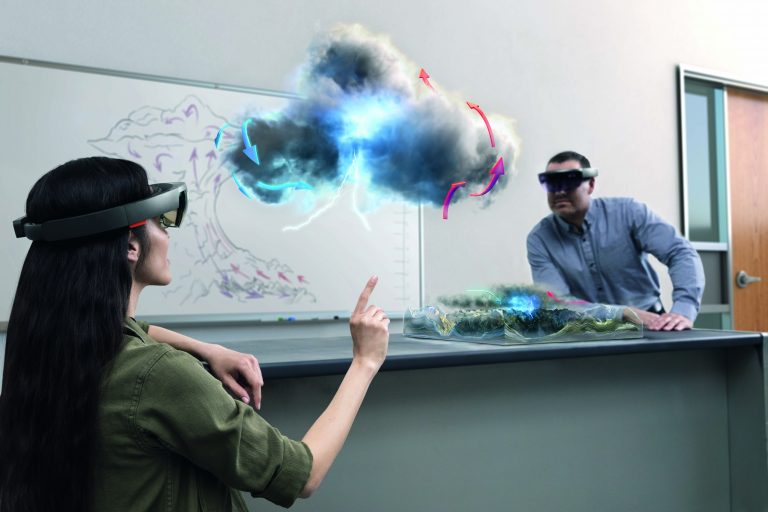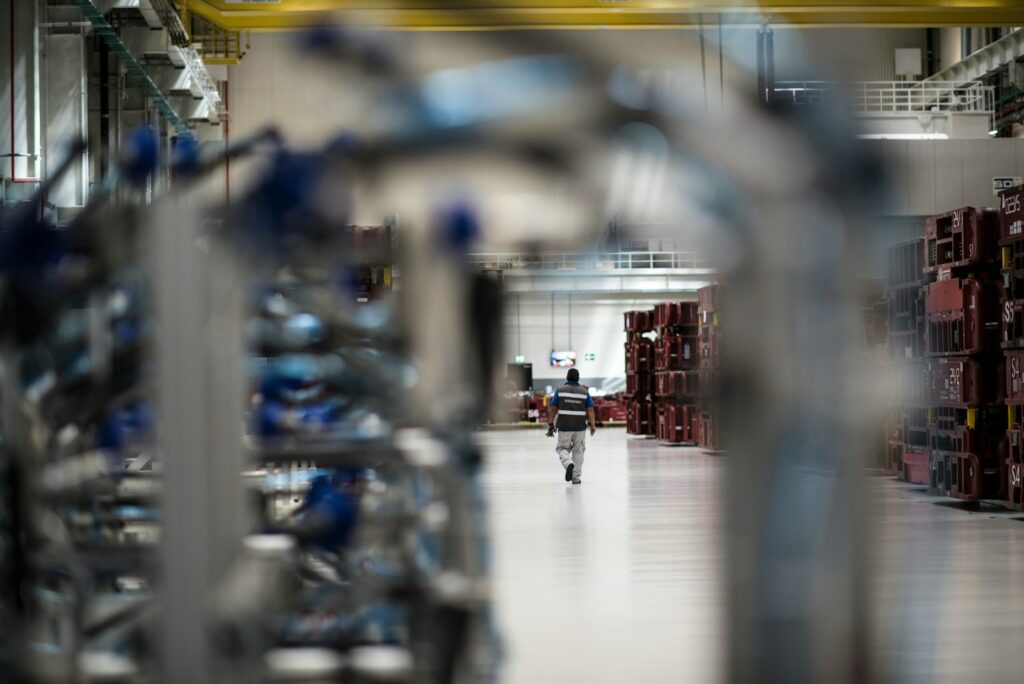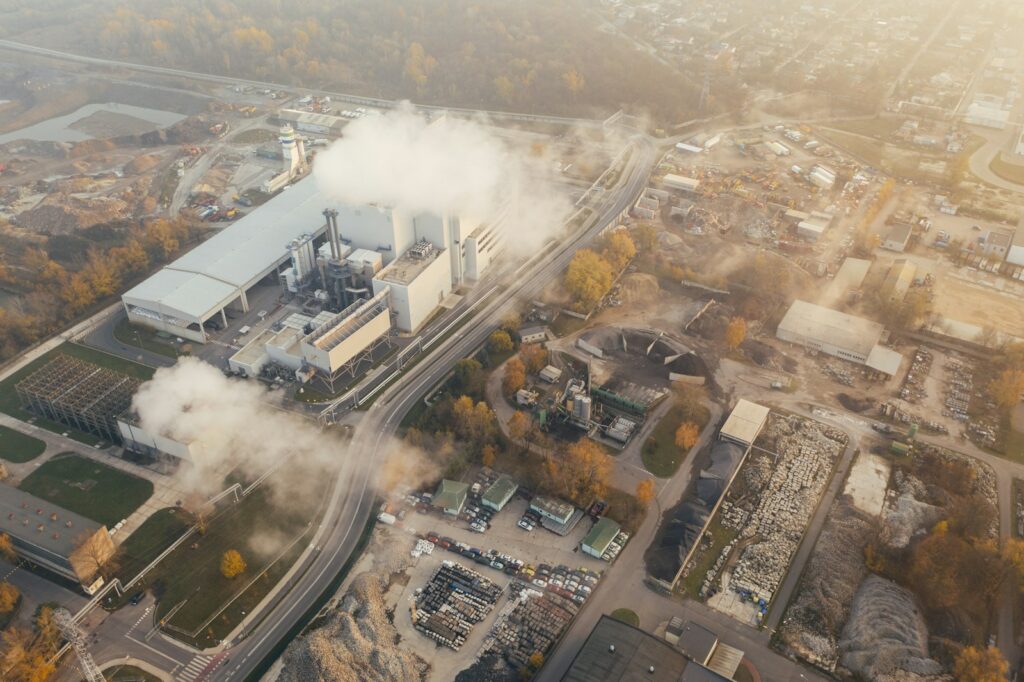With a market cap of $1.8 Trillion, Microsoft is widely known for its software and IT solutions for end users. The tech giant is also a key player in gaming, cloud computing, and computer hardware. However, one of their most recent notable visions is creating products, services, and technology for the Microsoft Metaverse.
The concept of “Mixed Reality” is unique, as it incorporates both augmented and virtual reality by superimposing 3D virtual objects onto real-time surroundings. Microsoft’s state-of-the-art headset, the HoloLens 2, allows users to interact with virtual objects and has made significant breakthroughs within the industrial realm. Big companies such as Heinz and Kawasaki are already using this headset to resolve supply chain issues.
What Is Microsoft Metaverse
The Metaverse is built on Microsoft Mesh, an already established product. The software enables users to participate in shared holographic experiences from multiple physical places. People will share and communicate more inventively when used in conjunction with Microsoft Teams’ productivity tools.
Identical to many of its post-lockdown offerings, Mesh uses avatars and immersive digital environments to promote teamwork and reduce meeting fatigue. With these new three-dimensional avatars in Mesh, you can communicate without relying on a static profile image by making eye contact, interpreting facial emotions, and reading body language. In addition, users can fully customize the avatars according to their needs.
When Did Microsoft Get into Metaverse?
Microsoft unveiled Mesh during the Ignite event in 2021. It was positioned as an innovative solution to help foster productive virtual collaborations and increase workforce connectivity. This will be crucial to keeping these employees involved with the company, as many organizations have agreed to a distant or mixed working structure with their staff. There will be less desire to keep the webcams on during the discussion, and staff should feel more at ease working and interacting in video meetings using avatars and other 3D holograms. This new method of working would increase teamwork and make staff feel more connected to one another.
You may also like:
- A Closer Look At the Google Metaverse [2022 Review]
- Upland Metaverse: Everything You Should Know About It [2022]
- Will Apple Metaverse Become the New Meta in 2023?
Microsoft Metaverse Products
Microsoft Metaverse is compatible with many products we generally know as headgear/glasses. However, they are from different brands and have other functions. Here are a few of the products Microsoft designs to support its version of the Metaverse.
HP Reverb G2
This Metaverse headset was built in collaboration with Microsoft and Valve. It is one of the main components of Microsoft’s “Mixed Reality,” as it allows users to have a 144-degree field of view with HD 2160×2160 resolution. In addition, its ergonomic design allows for maximum comfort, which makes it a good headset for long-term use.
The headset also allows utilizing a “half-resolution” setting to allow for reduced hardware requirements. The quick refresh rate and incredible visuals make this one of the best headsets on the market today. It is currently priced at $349.99.
Microsoft HoloLens
This MR headset is one of Microsoft’s most significant innovations within the Metaverse space. The headset utilizes several sensors, cameras, microphones, and an HPU (Holographic Processing Unit). As a result, the headset offers incredible processing features, which are more powerful than most standard laptops.
With the help of prebuilt algorithms, cameras, and sensors, the headset maps the user’s real-time environment. It overlays holograms/3D virtual objects into a user’s surroundings to create a “mixed reality .”Since the primary target audience for the HoloLens 2 is industries, the headset is very pricey, starting from $3,500 for the base model. However, despite its high cost, this MR headset is said to provide more user immersion than any hardware in the market today.
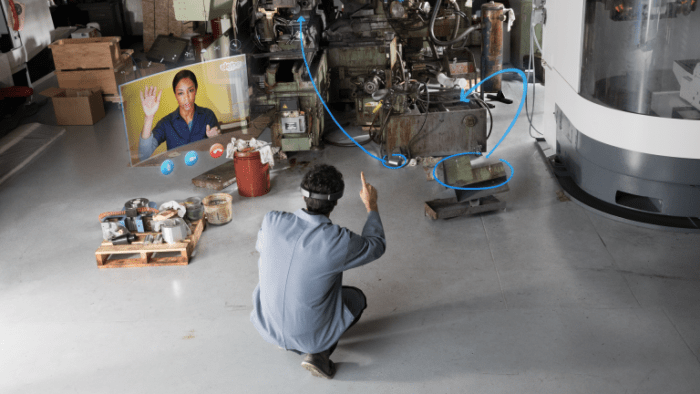
Microsoft Metaverse Services
Microsoft has offered many software services over time. However, after reorienting its focus towards building the Metaverse, Microsoft has developed numerous vital services to cater to rising needs within the virtual realm. Here are a few services offered by the Microsoft Metaverse:
Microsoft Metaverse Teams
In 2017, Microsoft Teams was first introduced as a productivity tool. It has been continuously updated to support businesses in managing their staff since that original release. However, Teams started to join the greater Microsoft metaverse in 2022 formally. This resulted from integration with Mesh. People can now utilize Teams to build shared, virtual workspaces, thanks to Mesh.
This may be utilized for conferences, team projects, or anything else that benefits from face-to-face communication. Studies in progress have revealed that employing these Metaverse technologies makes people feel more involved and present. As a bonus, Microsoft Teams can also work with AR/VR, completely changing the dynamics of project collaborations, virtual workspaces, and more.
Microsoft Dynamics 365 Connected Store
This store enhances in-store operations using real-time observational information and data collection.
- Microsoft Dynamics 365 Guides
The Microsoft Dynamics 365 guide helps frontline employees perform their jobs more effectively and accurately by providing a holographic overlay of detailed instructions over natural environments.
- Microsoft Dynamics 365 Remote Assist
Allows workers to collaborate in mixed reality with experts from anywhere globally while sharing a common virtual realm of the actual world. As a result, there are no longer any physical barriers between enterprises, allowing for extensive information transfer and training.
- Connected Field Service
The connected field service of Microsoft immediately on auto-mode summons a repairman when a machine requires assistance and aids businesses in scheduling maintenance.
Securing Microsoft’s Metaverse
Naturally, with all of this sophisticated technology comes sophisticated security. The globe has benefited much from the internet. But if individuals enter it untrained, there are many online security risks. Microsoft is striving to protect its Metaverse so that users may access it securely. Establishing proper identification and securing data is one of the most important forms of security. Through several technologies, the Microsoft Metaverse strongly focuses on preventing identity theft. This covers establishing multi-factor authentication and more extensive platform-based interoperability.
Microsoft Metaverse Games
People frequently draw comparisons to video games when presenting prior instances of the Microsoft Metaverse. So it’s not strange that people connect the two, either. And besides, both the Metaverse and video games provide digital representations of ideas in the real world. Earlier, Microsoft CEO Satya Nadella asserted that developing Metaverse games is precisely what the Metaverse is all about, utilizing a digital physics engine to permit all components to communicate after including digital models of real-world objects in the engine.
Microsoft Metaverse Technology
Azure Cloud powers Microsoft’s Mesh. By “converging” both physical and digital worlds through MR, this innovative technology is reshaping the way humans will interact virtually. In addition, Azure Digital Twins assists in modeling real-life objects and environments through interactive analytics, cameras, sensors, and image processing algorithms. Used alongside MR devices such as the HoloLens 2, this powerful technology is fully positioned to reshape the era of alternate realities.
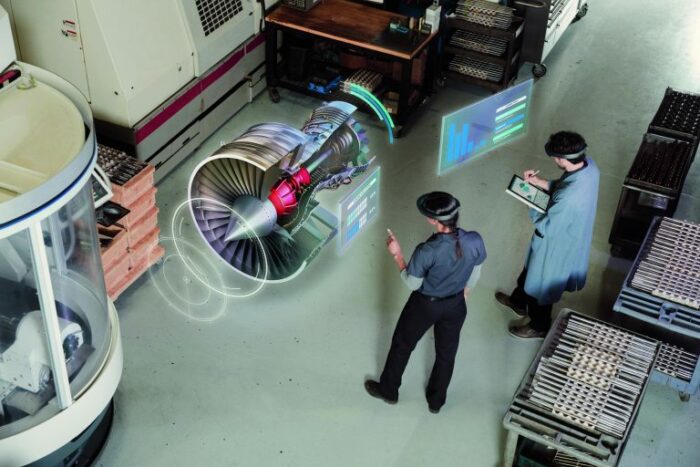
Who are Microsoft’s Main Competitors in Metaverse
The most significant competitors for Microsoft in the Metaverse are Apple and Meta. Both tech giants are making great waves in the Metaverse space, with Apple leading the AR revolution and Meta working on building its Metaverse “Horizon Worlds” and their massively successful headset “Meta Quest 2”.
There is a difference in the vision of these companies, though. While all of them seek borderless immersion, the vision of Mesh is to connect the physical and virtual worlds to enable users to have shared experiences that can be applied to numerous real-life problems. However, the vision of Meta is to provide virtually dependent social media relationships and interactions.
There are several other competitors, including; Disney, Roblox, Autodesk, Nike, Amazon, and many others.
Microsoft Metaverse Partnerships
One of the prominent and most significant Microsoft Metaverse partnerships is with Meta. They have partnered to create the future virtual office, allowing users to use Microsoft Office 365 and others using VR devices. Here is what this partnership will bring to the users.
They are first delivering Meta Quest devices Mesh for Microsoft Teams. Mesh for Teams is the culmination of years of study and Microsoft Cloud innovation, including Dynamics 365 Remote Assist, Azure Digital Twins, and Teams video meetings. It is intended to make it easier for individuals to virtually congregate in the workspace using any device, including mobile phones, computers, and headgear.
Using these headsets, users can step into virtual worlds where they can utilize avatars to represent their presence. In addition, avatars can help them interact and connect with other individuals online, thus creating an interactive space for collaboration.
This can be massively beneficial in office settings where offices can connect with remote workers and utilize Microsoft 265 programs on their MetaQuest 2 headsets. In addition, the workers will be able to use all main programs such as PowerPoint, Excel, and Word.
The collaboration takes interactivity further by utilizing Azure and Microsoft Intune to incorporate customized safety solutions into their VR headsets. Gaming enthusiasts also have plenty to be excited about, with plans to include Xbox Cloud Games to Meta Quest, making them widely accessible.
This cooperation strengthens Microsoft’s dedication to HoloLens. They are eager to advance our vision for mixed reality gadgets while putting Windows and Microsoft 365 at the forefront and leading with their cloud-first strategy. All of this furthers efforts to provide the groundwork for a sustainable Metaverse, with corporate-level experiences, safety, and accountability serving as the cornerstones of how they will continue to open up new opportunities for the next generation of workers.
What the Future Holds for Microsoft Metaverse
With exciting innovations from other tech companies, such as haptic gloves, AR contact lenses, and more, many wonder what Microsoft has in store for the future.
Accessible Mixed Reality
While mixed reality is not readily accessible to ordinary customers due to its exorbitant price, Microsoft has stated that they plan on creating a much more cost-effective version of their headsets. In addition, with interactive office tools that can be utilized within Mesh, the Microsoft Metaverse will aim to incorporate more productivity-oriented solutions to solve real-life problems.
Identity Safety
Cyber security and identity theft are among the significant issues in the Metaverse, and since it is a developing project, it is still vulnerable in terms of security. However, Microsoft holds the key to the Metaverse future along with others. It is working for a secure Metaverse for users to provide virtual workplaces from their homes without any attacks from hackers, etc.
Transparency and Interoperability
As mentioned above, security is among the significant issues regarding fully immersive platforms, especially the idea of the Metaverse. Along with security, transparency of the technology and the gap it holds from the previous technologies is essential to overcome if a brand wants to succeed. Microsoft knows that, and they are working to make their products and services as transparent as possible so that their consumers can communicate with them if there are any issues. They can build a Metaverse where everyone can come together without problems.
New Metaverse Releases
We expect to see many more exciting releases in terms of better headsets equipped with haptic sensors and compatible with a complete bodysuit. However, with Microsoft’s vision for efficient industrial workplaces, there is still a lot of room for them to innovate and improve.
More Exciting Collaborations
Microsoft and NVIDIA are destined to collaborate at some point in the future, with NVIDIA’s omniverse and Microsoft’s Mesh providing solutions to real-time problems. The omniverse provides a robust 3D development framework for developers to use to collaborate effectively. This assists immensely in creative interactive online worlds, where developers can quickly utilize prebuilt modules to create unique items. Similarly, Mesh provides online spaces for individuals to collaborate, introduce new ideas, and much more.
See also: What is Metaverse? Guide into the Future of Digital Reality
FAQs
- Is Microsoft a part of the Metaverse Universe?
Yes! Microsoft launched its Metaverse platform in 2022 called Mesh. It offers various exciting features focused on reshaping the future of digital workplaces where users can work, swap files, videos, and more.
- Are Meta and Microsoft working together in the Metaverse?
Meta has partnered with Microsoft to bring different workplace solutions using Microsoft 365 and Teams with the Meta Quest Devices so users can get the most out of the Microsoft Metaverse.
- Is Microsoft a big player in the development of the Metaverse?
Yes! Microsoft is one of the largest tech companies investing heavily in the Metaverse. With its mixed reality concept, Microsoft is incorporating the best of AR and VR to provide more immersion than ever before.


